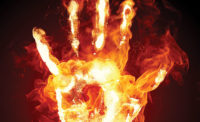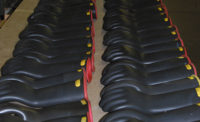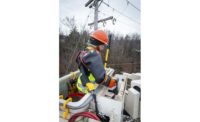In 2012, the National Fire Protection Agency (NFPA) changed the way personal protective equipment is rated. Instead of only having a Flame-Resistant (FR) rating, now there’s an Arc Flash rating as well (denoted as AR, which stands for “Arc Rated”). This change evidently came about for a reason: in recent years, there has been a staggering increase in the number of arc flash incidents in the workplace, with many resulting in fatalities.
Although this type of hazard affects many workers each year, what an arc flash? An arc flash occurs when an electrical current jumps from the desired electrical path, and travels through the air from one conductor to another. When this happens, anyone who is in the path of the discharge, or nearby, can become badly injured – or, frighteningly, even killed.
The best way to prevent these types of injuries is to educate yourself about arc flashes, their common causes, as well as how you can protect your workers from these types of excruciating electrical burns. Depending on the industry you work in, there are a large number of factors that can cause an arc flash to occur within your workplace. Make yourself aware of these risks and you can personally help minimize the occurrence of arc flash within your workplace.
In workplaces with high voltages or current machinery, some of the most common causes of arc flashes include the following: airborne dust particles that can provide a path for electrical currents; worn out or thinning insulation; corroded contacts; dropped or improperly used tools; improper or incomplete installation of equipment; and accidental human contact due to inappropriate gloves or other PPE.
The fact that arc flashes often occur because workers are wearing the wrong gloves (or other types of PPE) is something I’d like to draw your attention to in this article. It’s not only a huge factor in the frequency of arc flash occurrences, but it’s also extremely preventable.
The right gloves
In order to help minimize the risk of arc flash as well as the painful aftermath that accompanies it, I’ve compiled a list of everything you need to consider during your search for arc-rated hand protection. Here are my top six tips to help you ensure that your workers are wearing the right pair of work gloves.
1. Ensure employees are wearing flame-resistant PPE.
Though it may seem obvious, wearing gloves or other PPE that will burn, ignite, or fail to prevent heat damage is one of the absolute worst things that your employees can do in workplaces where arc flashes are a threat.
2. Anyone who works where sparks or flames are present should wear flame-retardant (FR) gloves.
It’s crucial that if your workers are going to be exposed to sparks or flames while they’re on the job that they wear flame-retardant gloves so that their hands are properly shielded. According to section 1910.193 (a), OHSA requires employers to provide appropriate hand protection to employees based on the hazards that they’ll be exposed to in their workplace; this includes all types of burn and flame hazards. Ensure all employees know it’s mandatory to wear the assigned PPE to help to ensure worker compliance.
3. Currently, the ASTM F2675-13 test is the standard method for determining the arc ratings of gloves designed for electrical arc flash protection.
Workers operating meters should always be wearing rubber insulated gloves with some sort of protector glove over top. (At the moment, the ANSI/ISEA 105 method does not include arc flash testing.) Also, when you’re looking for an arc-rated glove, ensure that manufacturers are comparing glove options by the same types of standards and principles. This ensures you’ll be able to accurately determine which pair of gloves will better protect your employees. Apples to apples, oranges to oranges, right?
4. Anytime there is a risk of exposure to a shock hazard, workers should always be wearing a rubber insulating glove.
For this reason, workers operating meters should always be wearing rubber insulated gloves with some sort of protector glove over top. Unfortunately, meter malfunctioning is a common cause of electrical burns. Because of this, it’s important that workers using meters wear rubber insulating gloves underneath their protector gloves, since the rubber will block the electricity from passing through to their hands and shocking them. OHSA also recommends that workers wear a protector glove over top of the rubber insulating gloves.
(Bonus tip: If workers require rubber insulating gloves, check with the manufacturer to ensure that the protector gloves will fit over top of the rubber inserts. Otherwise, your workers’ hands will be protected, but the gloves you’ve chosen could affect their job performance – which you definitely don’t want.) As well, whenever a shock hazard is present, it’s always preferable to wear gloves that are voltage-rated.
5. Consider all of the hazards – not just the arc flash-related ones.
Today, certain types of leather gloves are often worn on top of these rubber inserts, but in the future, these gloves might be made from other materials. Although leather gloves provide good protection from arc flashes, they aren’t necessarily the best choice for comfort, cut protection, or chemical protection. It’s important to ensure workers’ hands are not only protected from arc flashes, but from all of the other hazards that they may come across during their workday as well. The best way to do this is to evaluate your workplace and its inherent risks. Otherwise, though you may have taken the time to prevent one type of injury, there’s a good chance that employees could end up suffering from one of a different nature.
Evaluate if workers require other arc-rated PPE, in addition to arc-rated gloves. Depending on the severity of the risk of arc flashes in your workplace, arc-rated sleeves can be worn alongside gloves for additional arc flash protection. The more proper coverage, the better – right?
I hope that these tips will help reduce the risk of arc flashes, and as a result, help you make your work environment a much safer place. For additional information about hand protection options for specific applications, contact a glove expert.



